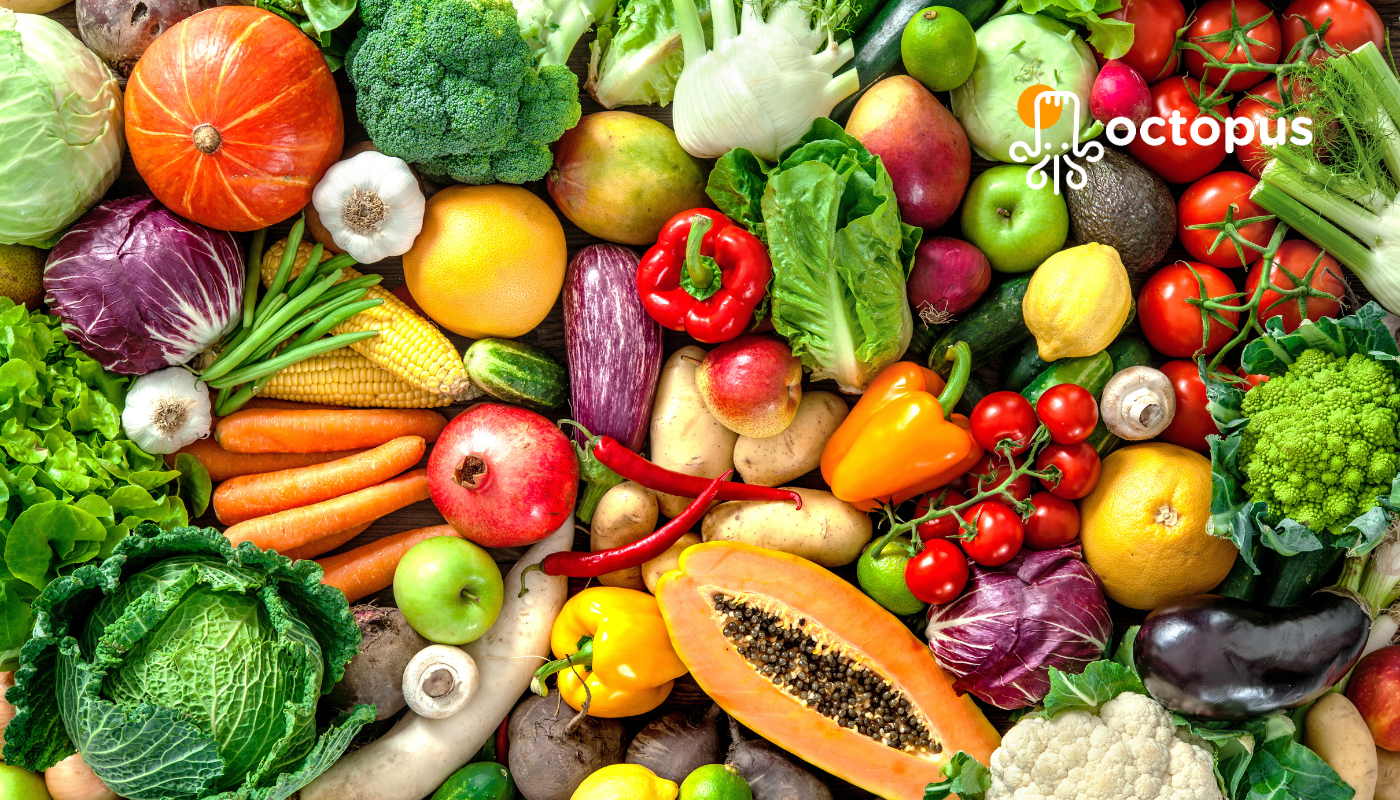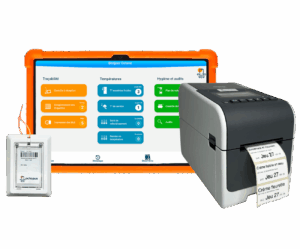Fruit and vegetable disinfection protocol: download your PDF
Nettoyer et désinfecter
⏳ Temps de lecture : 6 min
? Mis à jour le : 20/10/2024
This article provides a practical guide on best practices for disinfecting your fruits and vegetables while complying with regulations. Additionally, we’re offering a downloadable fruit and vegetable disinfection protocol in PDF format, ready to print and display in your produce preparation area. ?
Why is produce decontamination important? ?
When you receive vegetables in your kitchen that have been in contact with soil or sand and haven’t been pre-washed, decontamination seems obvious ?️. But even when fruits and vegetables appear clean, they may contain invisible contaminants such as microorganisms, pesticides or soil residues. In both cases, decontamination is essential! ?️
What does HACCP regulation say? ?
Generally, the HACCP method recommends conducting a hazard analysis of critical control points in your establishment to identify and mitigate risks from pathogenic microorganisms. Implementing a produce disinfection protocol helps reduce contamination risks.
We have created a fruit and vegetable disinfection protocol, available as a free PDF download.
What are the risks associated with microorganisms on produce? ?️
There are various types of risks related to microorganisms on fruits and vegetables:
- Microbiological risks ?: Environmental germs or animal intestinal flora can contaminate produce. Common bacteria include listeria, salmonella, and E. coli. These microorganisms can cause gastroenteritis and, in severe cases, life-threatening complications. Handling and preparation can also introduce microbiological risks. For example, staphylococcus, often present on human skin, can contaminate produce through contact.
- Mold ?️: Some mold-contaminated produce can produce mycotoxins – toxic substances that may be neurotoxic or immunotoxic. For example, patulin, which develops in moldy apples and apple products, poses health risks.
- Parasites ?️: Improperly washed salad greens or root vegetables may contain toxoplasma, a parasite that can cause serious complications in pregnant women and high risk of fetal malformations.
- Chemical residues ?: Produce may contain pesticide residues, pollutants, or food processing chemicals. Decontamination is therefore recommended.
- Physical particles ?: Vegetables and sometimes fruits may contain soil, sand, stones, or even plastic/glass fragments. Removing these particles is essential.
Is produce decontamination only mandatory in institutional catering? ?
No! Produce decontamination isn’t just an obligation for institutional catering. While institutional catering follows strict Food Safety Management Systems, all food service businesses and food trades, regardless of size, must implement proper hygiene practices including raw produce decontamination. ?️
Which fruits and vegetables require decontamination? ?
Raw-consumption produce
Produce meant to be eaten raw, like salads or fresh fruits, requires special treatment. Since they aren’t cooked, microorganisms and pesticide residues must be eliminated. Examples include lettuce, tomatoes, cucumbers, carrots, radishes, apples, etc. ?
Peeled produce
Fruits and vegetables that will be peeled should also be disinfected before peeling. Even when skin is removed, contaminants (like soil) can transfer to edible flesh during peeling. Examples include potatoes, carrots, melons, etc. ?
Produce destined for cooking
Even though cooking eliminates many microorganisms, vegetables meant for cooking should still be disinfected. This is particularly important for vegetables cooked at temperatures insufficient to kill pathogens. ?
Special cases: Leafy greens, berries, aromatic herbs
Leafy greens like lettuce, spinach, sorrel, as well as berries and aromatic herbs require extra decontamination precautions. Their delicate texture retains moisture and promotes contamination. ?
Which products are approved for produce decontamination??
Approved products for fruit and vegetable disinfection
For effective and regulation-compliant disinfection, it’s recommended to use approved products ✅. Commonly used disinfectants include chlorine-based solutions like bleach. Each product must be properly dosed according to manufacturer instructions to ensure effective decontamination.
Can vinegar be used to decontaminate produce?
White vinegar has antibacterial properties, particularly against certain microorganisms ?. However, this natural solution, while effective when properly dosed, is not approved as it doesn’t provide complete effectiveness against viruses and bacteria. Vinegar disinfection is therefore not recommended.
What is the protocol for decontaminating fruits and vegetables? ?
A well-structured protocol enables implementation of a forward-moving process, ensuring disinfected produce doesn’t return through contaminated areas. To assist with this process, we’ve created a PDF guide detailing all produce disinfection steps. In some environments like institutional catering, protocols are even more rigorous.
Produce Preparation Station Organization
The most efficient approach is to establish three distinct zones in your produce prep area: an initial washing zone, a disinfection zone, and a final drying/storage zone. All equipment used during decontamination – including bins, sinks, and utensils – must be disinfected to prevent cross-contamination. ✅
Produce Preparation
Before disinfection, remove major surface dirt. An initial rinse under running water helps eliminate soil residues and debris. Use cold water, as hot water could damage (or partially cook) the produce. Firm-skinned vegetables like potatoes may be gently brushed to remove embedded dirt. This is also the stage to remove damaged portions of fruits and vegetables. ?
Selecting a Disinfection Solution
Several methods exist for produce decontamination, with the most common being:
- Specialized products ?️: The market offers numerous produce disinfectants that simplify dosing: Hydrachim’s Déterquat, Ecolab’s Mikrochlor liquid, Hygiène et Nature’s Chlor’Légumes, Jex Pro’s fruit and vegetable disinfectant, Christeyns Food’s Mida San vegetable disinfectant, etc. Consult your supplier to identify the product best suited to your operation.
- Bleach solution ? : This requires careful handling as it can become corrosive and leave strong odors. Bleach has no detergent properties, so ensure produce is thoroughly cleaned before disinfection.
Soaking and Rinsing Times
A 5-10 minute soak is sufficient to eliminate microorganisms on produce. Refer to the soaking time indicated on your disinfectant product’s technical sheet. After soaking, rinse thoroughly with clean water to remove all disinfectant residues. This final rinse ensures chemical cleanliness – a crucial step! ?
Drying and Storage After Disinfection
After proper rinsing, drain or spin dry according to produce type, then air-dry your fruits and vegetables. Once dry, store at 0-4°C (32-39°F) in refrigeration. These low temperatures slow bacterial growth while preserving produce flavor and texture. ?
Downloadable PDF: Fruit and Vegetable Disinfection Protocol ?
To assist you, we’ve created a fruit and vegetable disinfection protocol PDF, available free of charge. This guide will help you and your team follow clear steps to ensure proper produce decontamination.
Simply complete the form to receive the fruit and vegetable disinfection protocol by email! ?





